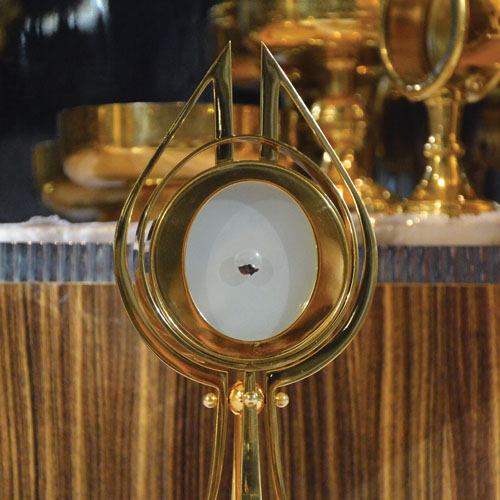Polish ‘Eucharistic Miracle’ in Legnica
Forensic Specialists Determine Host Is Heart Tissue; Vatican to Review the Case

LEGNICA, Poland — On Christmas Day 2013 at St. Hyacinth’s Shrine in Legnica, an industrial city of 100,000 in southwest Poland, a priest accidentally dropped a consecrated Host on the floor. In accordance with Church procedures, the Host was placed in a dish filled with holy water to dissolve. After two weeks, the Communion wafer dissolved only partially, and a red substance appeared on it.
The bishop of Legnica at the time, Stefan Cichy, formed a committee to study this unusual phenomenon.
Two independent forensic medicine departments from universities in Wroclaw and Szczecin studied a sample of the Host. Researchers from Szczecin found human DNA, as well as tissue from the human heart, with alterations that frequently appear in a state of agony.
This year, Bishop Cichy’s successor, Bishop Zbigniew Kiernikowski, recognized the miracle.
“I became the bishop of Legnica in June 2014, after the event in St. Hyacinth’s parish. When I learned that my predecessor, Bishop Cichy, had formed a diocesan committee and asked forensic medicine departments to study this, I confirmed the committee’s members, and everything took its course,” Bishop Kiernikowski told the Register in written correspondence. “Then we had the results from Szczecin and Wroclaw. Now we will have to wait for the Congregation for the Doctrine of the Faith’s decision before officially calling it supernatural.”
On April 10, Bishop Kiernikowski read a communiqué at a Mass celebrated in St. Hyacinth’s Shrine in which he described what happened to the Host and said that he believed the possible miracle appears authentic.
“I asked Father Andrzej Ziombra, the parish priest at St. Hyacinth’s, to find an appropriate place to display the Host, so that the faithful can express their devotion to it, and to create a book where graces and other events of a supernatural nature would be registered,” the bishop explained.
This documentation will be compiled and sent to Rome. The Vatican, through the Congregation for the Doctrine of the Faith, will review the matter; after review, it will pass a verdict.
On July 2, the Host was placed in a reliquary for public view in St. Hyacinth’s. More than 3,000 faithful attended a liturgy of expiation in the Legnica cathedral and subsequent procession to St. Hyacinth’s Shrine, where the reliquary was installed in the church’s main altar during a Mass celebrated by Bishop Kiernikowski.
If this miraculous occurrence is approved, it will join the 133 Eucharistic miracles officially recognized by the Vatican. The oldest and best known took place in Lanciano, Italy, around the year 700, when a priest who doubted the Real Presence saw a Host turn into human flesh and wine turn into blood while celebrating Mass. In 1970, Italian researchers studied the Lanciano Host and found that it not only contained human flesh and blood, but that the blood type was AB, the same type as that which was found on the Shroud of Turin and in other approved Eucharistic miracles.
The most recent Vatican-approved Eucharistic miracle took place in Buenos Aires, Argentina, in 1996; the Host likewise had an AB blood type. Strong evidence for the divine origin of these miracles is that they not only feature the same blood type, but that the AB group is relatively rare, yet is common in the Middle East and among Jews, so it is probable that Jesus had this blood type. In the case of the Legnica Host, however, because it only contains heart tissue, blood type was not analyzed.
Understandably, the events in Legnica attracted significant media attention in Poland. Not all of it, however, has supported the claim that the Host is of divine origin. Gazeta Wyborcza, a Polish daily newspaper, published an article arguing that Serratia marcescens bacteria thrives on bread and can create copious amounts of a red substance similar to blood. This turned out to be the case in a recent occurrence in Utah, but when asked about this possibility by the Register, Father Waldemar Wesolowski, press secretary of the Diocese of Legnica, says that the bishop specifically asked the doctors in Wroclaw and Szczecin to check if the red pigment had bacterial or fungal origin, and they found no such evidence.
Bishop Kiernikowski hopes that this miraculous Host will strengthen Eucharistic devotion among his flock. “I asked Father Ziombra to prepare catechesis that would appropriately shape the faithful’s awareness of Eucharistic devotion,” he said. Legnica is one of Poland’s least-religious dioceses, where weekly Mass attendance stands at just 29.9% (compared to the national average of 39.1%), so it could well use increased Eucharistic devotion.
“As I wrote in my communiqué [that] I read in St. Hyacinth’s Church, I hope that this all will serve to deepen Eucharistic devotion and will impact the lives of those who come near this relic. We interpret this amazing sign as an expression of the generosity and love of God, who stoops so low to be with man.”
Filip Mazurczak writes
from Washington; he is covering
World Youth Day in Poland
for the Register.
- Keywords:
- July 24-Aug. 6, 2016
















